As a follow-up of my previous too generic question
I have a signal generator (shaft encoder) that has 2 NPN outputs. I have a high speed counter that needs PNP signals. How can I convert the encoder signals, so the counter can use them. Both encoder and counter have a supply voltage of 24VDC. The counter can count up to 30 kHz, so speed is also important.
UPDATE: As was guessed in the comments, this is indeed for industrial machinery. An old bending machine's (iron pipes) logic is broken and is being replaced by something completely new. It's while trying to get everything connected again, that this problem showed up.
My dad is the one who has replaced the old 1970's circuits by a PLC, and reprogammed the entire thing. (He's a retired bending machine architect/engineer).
What he's bumping into is that one issue with the incompatibility between the encoder and the generator. Since electronics isn't his specialty I convinced him that the internet might help him with these issues.
I'm sorry if we are using 'incorrect terminology'. We are non-native english speakers, and technical terminology is even more difficult to get right.
I'll ask my dad if he can supply a schema, or some part info which might shed light on the matter
